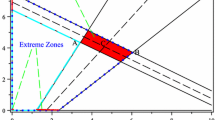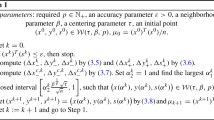Abstract
A new computational test is proposed for nonexistence of a solution to a system of nonlinear equations in a convex polyhedral regionX. The basic idea proposed here is to formulate a linear programming problem whose feasible region contains all solutions inX. Therefore, if the feasible region is empty (which can be easily checked by Phase I of the simplex method), then the system of nonlinear equations has no solution inX. The linear programming problem is formulated by surrounding the component nonlinear functions by rectangles using interval extensions. This test is much more powerful than the conventional test if the system of nonlinear equations consists of many linear terms and a relatively small number of nonlinear terms. By introducing the proposed test to interval analysis, all solutions of nonlinear equations can be found very efficently.
Similar content being viewed by others
References
G. Alefeld and J. Herzberger,Introduction to Interval Computations, Academic Press, New York, 1983.
G. Alefeld and J. Herzberger,A quadratically convergent Krawczyk-like algorithm, SIAM J. Numer. Anal., 20 (1983), pp. 210–219.
G. Alefeld and F. Potra,A new class of interval methods with higher order of convergence, Computing, 42 (1989), pp. 69–80.
E. Allgower and K. Georg,Simplicial and continuation methods for approximating fixed points and solutions to systems of equations, SIAM Rev., 22 (1980), pp. 28–85.
L. O. Chua and P. M. Lin,Computer-Aided Analysis of Electronic Circuits: Algorithms and Computational Techniques, Prentice-Hall, Englewood Cliffs, New Jersey, 1975.
E. R. Hansen,A globally convergent interval method for computing and bounding real roots, BIT, 18 (1978), pp. 415–424.
E. R. Hansen and S. Sengupta,Bounding solutions of systems of equations using interval analysis, BIT, 21 (1981), pp. 203–211.
M. Kashiwagi and S. Oishi,Numerical validation method for nonlinear equations using interval analysis and rational arithmetic, IEICE Trans., J77-A (1994), pp. 1372–1382 (in Japanese).
M. Kashiwagi,Interval arithmetic with linear programming—extension of Yamamura's idea, in Proceedings of 1996 International Symposium on Nonlinear Theory and its Applications, Kochi, Japan, October 1996, pp. 61–64.
R. B. Kearfott,Some tests of generalized bisection, ACM Trans. Math. Software, 13 (1987), pp. 197–220.
R. B. Kearfott,Preconditioners for the interval Gauss-Seidel method, SIAM J. Numer. Anal., 27 (1990), pp. 804–822.
R. B. Kearfott,Interval arithmetic techniques in the computational solution of nonlinear systems of equations: Introduction, examples, and comparisons, in Computational Solution of Nonlinear Systems of Equations (Lectures in Applied Mathematics, Vol. 26), E. L. Allgower and K. Georg, eds., American Mathematical Society, Providence, RI, 1990, pp. 337–357.
R. B. Kearfott,Decomposition of arithmetic expressions to improve the behavior of interval iteration for nonlinear systems, Computing, 47 (1991), pp. 169–191.
R. B. Kearfott and V. Kreinovich, eds.,Applications of interval computations, Kluwer Academic Publishers, Dordrecht, 1996.
R. Krawczyk,Newton-algorithmen zur bestimmung von nullstellen mit fehlerschranken, Computing, 4 (1969), pp. 187–201.
R. E. Moore,A test for existence of solutions to nonlinear systems, SIAM J. Numer. Anal., 14 (1977), pp. 611–615.
R. E. Moore,Methods and Applications of Interval Analysis, SIAM Studies in Applied Mathematics, Philadelphia, 1979.
R. E. Moore and S. T. Jones,Safe starting regions for iterative methods, SIAM J. Numer. Anal., 14 (1977), pp. 1051–1065.
R. E. Moore and L. Qi,A successive interval test for nonlinear systems, SIAM J. Numer. Anal., 19 (1982), pp. 845–850.
J. J. Moré,A collection of nonlinear model problems, In Computational Solution of Nonlinear Systems of Equations (Lectures in Applied Mathematics, Vol. 26), E. L. Allgower and K. Georg, eds., American Mathematical Society, Providence, RI, 1990, pp. 723–762.
A. Neumaier,Interval iteration for zeros of systems of equations, BIT, 25 (1985), pp. 256–273.
A. Neumaier,Interval Methods for Systems of Equations, Cambridge University Press, Cambridge, England, 1990.
S. Oishi,A difficult problem in numerical analysis with guaranteed accuracy is just solved, J. IEICE, 79 (1996), pp. 693–695 (in Japanese).
S. Pastore and A. Premoli,Polyhedral elements: A new algorithm for capturing all the equilibrium points of piecewise-linear circuits, IEEE Trans. Circuits and Systems I, 40 (1993), pp. 124–132.
W. H. Press, S. A. Teukolsky, W. T. Vetterling, and B. P. Flannery,Numerical Recipes in C, The Art of Scientific Computing, Second Edition, Cambridge University Press, New York, 1992.
L. Qi,A note on the Moore test for nonlinear systems, SIAM J. Numer. Anal., 19 (1982), pp. 851–857.
L. B. Rall,A comparison of the existence theorems of Kantorovich and Moore, SIAM J. Numer. Anal., 17 (1980), pp. 148–161.
H. Schwandt,Accelerating Krawczyk-like interval algorithms for the solution of nonlinear systems of equations by using second derivatives, Computing, 35 (1985), pp. 355–367.
H. Schwandt,Krawczyk-like algorithms for the solution of systems of nonlinear equations, SIAM J. Numer. Anal., 22 (1985), pp. 792–810.
J. M. Shearer and M. A. Wolfe,An improved form of the Krawczyk-Moore algorithm, Applied Math. Comp., 17 (1985), pp. 229–239.
J. M. Shearer and M. A. Wolfe,Some computable existence, uniqueness, and convergence tests for nonlinear systems, SIAM J. Numer. Anal., 22 (1985), pp. 1200–1207.
M. A. Wolfe,A modification of Krawczyk's algorithm, SIAM J. Numer. Anal., 17 (1980), pp. 376–379.
K. Yamamura,Exploiting separability in numerical analysis of nonlinear systems, IEICE Trans. Fundamentals, E75-A (1992), pp. 285–293.
K. Yamamura,Simple algorithms for tracing solution curves, IEEE Trans. Circuits and Systems I, 40 (1993), pp. 537–541.
K. Yamamura,Finding all solutions of piecewise-linear resistive circuits using simple sign tests, IEEE Trans. Circuits and Systems I, 40 (1993), pp. 546–551.
K. Yamamura,An algorithm for representing functions of many variables by superpositions of functions of one variable and addition, IEEE Trans. Circuits and Systems I, 43 (1996), pp. 338–340.
K. Yamamura,An algorithm for representing nonseparable functions by separable functions, IEICE Trans. Fundamentals, E79-A (1996), pp. 1051–1059.
K. Yamamura and K. Horiuchi,A globally and quadratically convergent algorithm for solving nonlinear resistive networks, IEEE Trans. Computer-Aided Design of Integrated Circuits and Systems, 9 (1990), pp. 487–499.
K. Yamamura, A. Tokue, and H. Kawata,Interval analysis using linear programming, IEICE Technical Report, CAS96-6, pp. 37–43, June 1996; also in Proceedings of 1996 International Symposium on Nonlinear Theory and its Applications, Kochi, Japan, October 1996, pp. 49–52.
K. Yamamura and M. Ochiai,An efficient algorithm for finding all solutions of piecewise-linear resistive circuits, IEEE Trans. Circuits and Systems I, 39 (1992), pp. 213–221.
K. Yamamura and T. Ohshima,Finding all solutions of piecewise-linear resistive circuits using linear programming, in Proceedings of 1995 International Symposium on Nonlinear Theory and its Applications, Las Vegas, Nevada, December 1995, pp. 775–780.
Author information
Authors and Affiliations
Additional information
Communicated by Kaj Madsen.
This work was partially supported by the Japanese Ministry of Education.
Rights and permissions
About this article
Cite this article
Yamamura, K., Kawata, H. & Tokue, A. Interval solution of nonlinear equations using linear programming. Bit Numer Math 38, 186–199 (1998). https://doi.org/10.1007/BF02510924
Received:
Issue Date:
DOI: https://doi.org/10.1007/BF02510924




